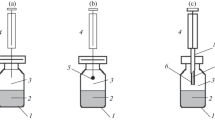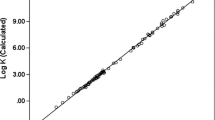Summary
The new phase ratio variation method is described which represents a convenient way for the determination of gas-liquid partition coefficients for practical purposes, utilizing equilibrium headspace-gas chromatography (EHS-GC). This method is based on the relationship between reciprocal peak area and the phase ratio in the vial containing the sample solution; it involves regression analysis of the EHS-GC measurements of a number of sample vials containing the same sample solution but with a wide variation of phase ratios. Examples are given for both aqueous systems and systems consisting of a stationary (liquid) phase used as the solvent; comparison of the measured values with results obtained by other methods shows satisfactory agreement. A critical discussion of the conditions influencing the accuracy of the analytical results is given.
Similar content being viewed by others
Abbreviations
- EHS:
-
equilibrium headspace (sampling)
- GC:
-
gas chromatography
- GLPC:
-
gas-liquid partition chromatography
- HS:
-
headspace (sampling)
- MHE:
-
multiple headspace extraction
- VPC:
-
vapor-phase calibration method for determination of the partition coefficient (EHS-GC)
- a:
-
intercept of Eq. (20)
- a′:
-
intercept of Eq. (27)
- a″:
-
intercept of Eq. (30)
- A:
-
peak area obtained when analyzing an aliquot of the gas phase (headspace) of the sample vial, in equilibrium with the sample (EHS-GC)
- A1, A2 :
-
peak area obtained in EHS-GC measurements corresponding to vials with respective phase ratios of β1 and β2
- b:
-
slope of Eq. (20)
- b′:
-
slope of Eq. (27)
- b″:
-
slope of Eq. (30)
- c *G :
-
concentration of the analyte in the gas phase (headspace) of vial, at equilibrium (EHS)
- c *L :
-
concentration of the analyte in the stationary (liquid) phase, at equilibrium
- c *M :
-
concentration of the analyte in the mobile phase, at equilibrium
- cS :
-
concentration of the analyte in the original sample (solution) in the sample vial (EHS)
- c *S :
-
concentration of the analyte in the sample phase (solution) in the sample vial, at equilibrium (EHS)
- fi :
-
proportionality factor
- j:
-
carrier gas compressibility correction factor (GC)
- k:
-
retention factor (capacity ratio) of the analyte
- K:
-
partition coefficient (distribution constant) of the analyte
- m *L :
-
amount of analyte present in the stationary (liquid) phase, at equilibrium
- m *M :
-
amount of analyte present in the mobile phase, at equilibrium
- r:
-
correlation coefficient of linear regression calculation
- rc :
-
inner radius of the chromatographic column
- tM :
-
hold-up time (retention time of a non-retained compound)
- tR :
-
retention time of the analyte
- t ′R :
-
adjusted retention time of the analyte
- T:
-
absolute temperature
- VG :
-
volume of the gas phase in the column (GC); volume of the gas phase (the headspace) in the sample vial (EHS)
- VL :
-
volume of the stationary (liquid) phase in the chromatographic column
- VM :
-
volume of the mobile phase in a chromatographic column in general; gas hold-up volume (retention volume of a non-retained compound) in GC)
- VR :
-
retention volume of the analyte
- V ′R :
-
adjusted retention volume of the analyte
- VS :
-
volume of the sample solution introduced into the vial (EHS)
- VV :
-
total volume of the vial (EHS)
- WL :
-
amount of the stationary (liquid) phase in the column
- β:
-
phase ratio of the chromatographic column (GC, LC); phase ratio of the sample vial (EHS)
- β1, β1 :
-
maximum and minimum phase ratio values of a series of sample vials containing the same sample solution but in different volumes (EHS-GC)
- πL :
-
density of the stationary (liquid) phase at column temperature
- ΦS :
-
sample phase fraction in the headspace vial (EHS)
- *:
-
asterisk refers to equilibrium conditions
References
P. E. Porter, C. H. Deal, F. H. Stross, J. Am. Chem. Soc.78, 2999–3006 (1956).
A. Kwantes, G. W. A. Rijnders, Gas Chromatography 1958 (Amsterdam Symposium, May 19–23, 1958),D. H. Desty, ed., Butterworths, London, 1958; pp. 125–136.
H. J. Lowe, K. Hagle, Gas Chromatography in Biology and Medicine (Ciba Foundation Symposium, London, February 5–6, 1969),R. Porter, ed., J. & A. Churchill Ltd, London, 1969; pp. 86–112.
B. W. Bradford, D. Harvey, D. E. Chalkey, J. Inst. Petrol.41, 80–91 (1955).
B. Kolb, C. Welter, C. Bichler, Chromatographia34, 235–240 (1992).
H. Hachenberg, A. P. Schmidt, Gas Chromatographic Headspace Analysis, Heyden & Son, London, 1977.
B. Kolb, ed., Applied Headspace Gas Chromatography, Heyden & Son, London, 1980.
B. V. Joffe, A. G. Vitenberg, Head-Space Analysis and Related Methods in Gas Chromatography. John Wiley & Sons, New York, 1984.
B. Kolb, Headspace-Gaschromatographie mit Kapillar-Trennsäulen, Vogel Verlag, Würzburg, 1986.
B. Kolb, P. Pospisil, T. Borath, M. Auer, J. High Resolut. Chromatogr./Chromatogr. Commun.2, 283–287 (1979).
L. S. Ettre, J. E. Purcell, J. Widomski, B. Kolb, P. Pospisil, J. Chromatogr. Sci.18, 116–124 (1980).
B. Kolb, P. Pospisil, M. Auer, Chromatographia19, 113–122 (1984).
L. S. Ettre, B. Kolb, Chromatographia32, 5–12 (1991).
B. Kolb, L. S. Ettre, Chromatographia32, 505–513 (1991).
B. Kolb, in ref. [7], pp. 1–11.
Author information
Authors and Affiliations
Additional information
Symbols which specifically refer to gas chromatography (GC), to equilibrium headspace sampling (EHS) and to EHS-GC are marked by the corresponding acronym.
Rights and permissions
About this article
Cite this article
Ettre, L.S., Welter, C. & Kolb, B. Determination of gas-liquid partition coefficients by automatic equilibrium headspace-gas chromatography utilizing the phase ratio variation method. Chromatographia 35, 73–84 (1993). https://doi.org/10.1007/BF02278560
Received:
Accepted:
Issue Date:
DOI: https://doi.org/10.1007/BF02278560




